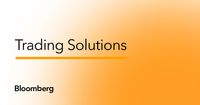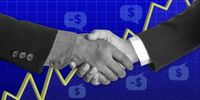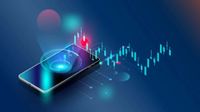Explore web search results related to this domain and discover relevant information.

Bloomberg’s end-to-end trading solutions give you the technology and access required to realize the potential of your trading workflows and experience.
Access 3,700+ dealers and gain greater price discovery and diversity with the industry’s leading source for pre-trade liquidity discovery.Bloomberg is the only firm offering a multi-asset automation solution through our Rule Builder and Algos, giving traders more time to focus on high-impact tasks.
Equity and index options carry a high level of risk and are not suitable for all investors. Certain requirements must be met to trade options through Schwab. Please read the Options Disclosure Document titled "Characteristics and Risks of Standardized Options" before considering any option ...
Equity and index options carry a high level of risk and are not suitable for all investors. Certain requirements must be met to trade options through Schwab. Please read the Options Disclosure Document titled "Characteristics and Risks of Standardized Options" before considering any option transaction.Futures and forex accounts are not protected by the Securities Investor Protection Corporation (SIPC). Forex accounts do not receive a preference in any bankruptcy proceeding pursuant to Part 190 of the CFTC’s regulations.Supporting documentation for any claims or statistical information is available upon request.Hedging and protective strategies generally involve additional costs and do not assure a profit or guarantee against loss.
Let’s go! Trading involves the buying and selling of financial assets, such as stocks, to earn profits based on the price fluctuations of these assets. There are different types of trading, and traders use various strategies, techniques, and tools to decide when to buy or sell different assets.
But don’t be discouraged! This article is a roadmap to help newcomers grasp the basics of what trading is and how it works.Ready to get started? Let’s go! Trading involves the buying and selling of financial assets, such as stocks, to earn profits based on the price fluctuations of these assets. There are different types of trading, and traders use various strategies, techniques, and tools to decide when to buy or sell different assets.Here’s a simple example: When the COVID-19 pandemic began and travelling suddenly wasn’t possible, airlines’ stock prices went down — · to the tune of a 12% single-day drop in mid-March. This was an opportunity for traders to buy cheap airline assets on the speculation that airline stock prices would go back up after the pandemic ended.When there are more buyers than sellers, demand increases — and so do the prices. When sellers outnumber buyers, demand shrinks, causing prices to fall. This can happen for many reasons: market trends, geopolitical events such as war or economic sanctions, natural disasters like droughts, or technological developments. Additionally, a trader's profit relies on the market price eventually matching their speculation — for example, our trader assumed that airline stock prices would increase again.Education and strategy: Traders have to learn about markets, different assets, and trading strategies. The more they learn, the more prepared they’ll be to make decisions — but still, that doesn't guarantee a profit.


O reality propõe um mergulho no comportamento automático, mostrando que sem encarar essas dores ocultas, não há consistência operacional.
Disciplina, gerenciamento de risco e estratégia técnica são os pilares mais conhecidos do trading profissional.Um dos erros mais comuns é tratar a indisciplina como o verdadeiro problema, quando, na verdade, ela costuma ser apenas o sintoma.O participante que não segue o plano, que movimenta o stop ou encerra a operação antes da hora, está geralmente fugindo de uma dor emocional mais profunda — ainda não identificada.Em um dos casos, um trader relatou medo de ser chamado de mentiroso.
The arrival of online trading, ... like Robinhood and Charles Schwab have made it easier than ever for retail investors to trade. Day trading can be lucrative as long as you do it properly (though there is never a guarantee)....
The arrival of online trading, which can be accessed with a reputable online broker platform, and the instantaneous dissemination of news, has leveled the playing field. Easy-to-use trading apps and the 0% commissions of services like Robinhood and Charles Schwab have made it easier than ever for retail investors to trade. Day trading can be lucrative as long as you do it properly (though there is never a guarantee).However, it's typically challenging for novices and often a losing way for newer investors to trade. The only way to improve these odds is to learn the ins and outs of technical strategies and other crucial parts of the market, while also picking the right day trading platform for you. So, what exactly is day trading, and how does it work?Successful traders often adhere to strict rules about position sizing and employ stop-loss orders to limit potential losses. They typically set a maximum amount they're willing to lose per trade—often no more than 1% to 2% of their trading capital—to ensure that a string of losses doesn't deplete their entire account.Individuals who attempt to day trade without understanding market fundamentals often lose money. A working knowledge of technical analysis and chart reading is a good start. But without a deep understanding of the market and its unique risks, charts can be deceiving. Do your due diligence and understand the particular ins and outs of the products you trade.
:max_bytes(150000):strip_icc()/GettyImages-1300319535-47217d4a6a714ef1a8b0562f17bbae9d.jpg)

Trading is a risky venture, and doing it successfully requires time and understanding the market. Trade smarter by setting your budget, risk tolerance, and trading strategy ahead of time.
Swing traders frequently use technical analysis, which involves analyzing trends in terms of both price movements and volume. Traders who use technical analysis believe that by examining a security's price and volume history, they can better understand what it will do in the future.When using position trading, investors may harness technical and fundamental analysis, which involves reviewing a company's "fundamentals," such as revenue and earnings, and determining its true worth. By doing this, you can better understand whether a particular security is undervalued or overvalued. · Scalping is a very short-term strategy involving making many trades daily to generate many small profits.Traders who use this strategy must be ready to exit a stock they purchased, even if it is on its way up. If a trader sells a stock, they can always buy back in again later. · Technical analysis involves studying a security's price and volume history to understand better what it will do next and identify the best times to enter and exit a position.Momentum traders look to benefit from trends in the price of a stock or other security. If a share of stock is trending higher, it will often continue to move that way. Once the momentum dies down, it's time to sell.

The value of your investments can go down as well as up and you may get back less than you put in. ... New customers can get £100 towards trading fees after opening an ii ISA or GIA. Offer ends 31 August 2025. ... The key difference between trading and investing is the length of time that shares are held. Day traders ...
The value of your investments can go down as well as up and you may get back less than you put in. ... New customers can get £100 towards trading fees after opening an ii ISA or GIA. Offer ends 31 August 2025. ... The key difference between trading and investing is the length of time that shares are held. Day traders usually buy and sell shares within a short period, often less than 24 hours, whereas investing is usually based on a ‘buy and hold’ strategy, with shares being held for several years.Swing trading: using technical analysis such as ‘support’ and ‘resistance’ to take advantage of short-term ‘up and down’ price movements (rather than longer-term trends) · News trading: trading before or immediately after news releases which may result in price movements · Scalping: placing a large number of very short-term trades, aiming to ‘scalp’ a small profit on each trade.It’s crucial to do your own research and, when evaluating a company or a fund, it’s vital that investors think about the risks as well as the potential rewards. Without the right mindset, it’s easy to get blinded by the potential for a big 10-times return on an obscure micro-cap stock. But remember that a stock trading at one pence can still lose 99% of its value (and fast). In addition to shares, traders can trade indices, ETFs and bonds, as well as foreign exchange and commodities.The content of this article is provided for information purposes only and is not intended to be, nor does it constitute, any form of tax advice. It’s worth taking the time to research fees, as these can make a serious dent in profits when high numbers of trades are made.

Most people who start day trading may not even realize that's what they're doing: buying and selling stocks to make a fast profit. Day trading means buying and selling investments quickly — often in less than a day — in an attempt to make money. If you're researching how to day trade, chances ...
Most people who start day trading may not even realize that's what they're doing: buying and selling stocks to make a fast profit. Day trading means buying and selling investments quickly — often in less than a day — in an attempt to make money. If you're researching how to day trade, chances are you're intrigued by the prospect of turning quick profits in the stock market.An example of an exit plan is deciding that you'll walk away from a trade once you've reached a certain percentage amount of profits (or losses). 3. Be patient. Look for trading opportunities that meet your strategic criteria. If the situation doesn’t meet it, don’t trade.Day traders who focus on stocks often rely on “technical analysis,” or analyzing the movements of stocks on a chart, rather than “fundamental analysis,” which involves examining company factors such as its products, industry and management. While some day traders might exchange dozens of different securities in a day, others stick to just a few — and get to know those well.A day trader might make a few hundred trades in a day, depending on the strategy and how frequently attractive opportunities appear. The above ground rules can help you avoid some of the biggest catastrophes in day trading, but it’s important to manage smaller risks, as well. Risk management is all about limiting your potential downside, or the amount of money you could lose on any one trade or position.

Before deciding to trade in financial instrument or cryptocurrencies you should be fully informed of the risks and costs associated with trading the financial markets, carefully consider your investment objectives, level of experience, and risk appetite, and seek professional advice where needed.
They do not reflect the views of Reuters News, which, under the Trust Principles, is committed to integrity, independence, and freedom from bias. (By Jamie McGeever; Editing by Nia Williams) Trading Day: Rallying into payrolls · View all comments (0)0 · Post · Comment Guidelines · Trade With A Regulated Broker ·Today’s Key Market Moves * STOCKS: China stumbles, Europe advances, Wall Streetrises strongly and evenly: three main indexes and Russell 2000all up 0.8-1.0%. * SHARES/SECTORS: Consumer discretionary +2.25%, utilitiesis the only U.S. sector in the red, down -0.2%. * FX: The dollar rises, up more than 0.5% against ZAR,NZD, SEK and NOK.Gold has recently surpassed the euro to become the second-largest global reserve asset after the U.S. dollar and, for the first time since 1996, gold represents a bigger share of central banks’ reserves than Treasuries.Central banks now hold 36,000 tons of gold, according to a European Central Bank study, having hoovered up huge volumes since the post-pandemic inflation spike and Russia’s invasion of Ukraine in 2022. They have increased their holdings by more than 1,000 metric tons in each of the last three years, a record pace and double the average annual purchases in the preceding decade.
A lot can happen during the market day that can result in market and stock volatility that can be a challenge for even the most experienced day trader. It can be especially difficult to check your emotions at the door when making investment decisions in this kind of environment, which may lead ...
A lot can happen during the market day that can result in market and stock volatility that can be a challenge for even the most experienced day trader. It can be especially difficult to check your emotions at the door when making investment decisions in this kind of environment, which may lead to some costly financial mistakes.By Lori Schock, Director of the SEC’s Office of Investor Education and AdvocacyThis sophisticated level of investing requires meticulous market and news monitoring, is fast moving, and involves a large amount of speculation. Professional day traders are typically very experienced and have a deep understanding of the markets, products, strategies, and the risks.Leveraged investing involves using borrowed capital to purchase stocks or other securities. Some examples of leveraged investing include sophisticated products, such as options trading, and margin trading. Leveraged investing may increase a day trader’s profit if a stock’s price or the market moves in the right direction.

If you're looking to invest and trade stocks for the long term, then one of the best online brokers is all you need. But if you're looking to day trade, you'll want to do your research and find a platform that fits your trading style best.
Trading is the buying and selling of securities, typically within a short timeframe. Browse Investopedia’s expert written library to learn more about how it works.Investopedia identified 26 trading platforms and then collected over 2,300 data points to determine which are the best for day traders. The best day trading platforms that made our list provide excellent apps for analyzing indicators and executing trades on a variety of securities including stocks, cryptocurrency, options, forex, futures, and more.Investing takes a long-term approach to the markets, while trading involves short-term strategies to maximize returns daily, monthly, or quarterly. Investors are more likely to ride out short-term losses, while traders will make transactions that can help them profit quickly from fluctuating markets.How much money you need to begin trading depends on the type of securities you want to buy. Stocks typically trade in round lots, or orders of at least 100 shares. To buy a stock priced at $60 per share, you will need $6,000 in your account. A broker may let you borrow half of that money, but you still need to produce the other $3,000.
Trading is the buying and selling of securities, typically within a short timeframe. Browse Investopedia’s expert written library to learn more about how it works.
Trading is the buying and selling of securities, typically within a short timeframe. Browse Investopedia’s expert written library to learn more about how it works.Investopedia identified 26 trading platforms and then collected over 2,300 data points to determine which are the best for day traders. The best day trading platforms that made our list provide excellent apps for analyzing indicators and executing trades on a variety of securities including stocks, cryptocurrency, options, forex, futures, and more.Investing takes a long-term approach to the markets, while trading involves short-term strategies to maximize returns daily, monthly, or quarterly. Investors are more likely to ride out short-term losses, while traders will make transactions that can help them profit quickly from fluctuating markets.How much money you need to begin trading depends on the type of securities you want to buy. Stocks typically trade in round lots, or orders of at least 100 shares. To buy a stock priced at $60 per share, you will need $6,000 in your account. A broker may let you borrow half of that money, but you still need to produce the other $3,000.
:max_bytes(150000):strip_icc()/tradingrecirc-13a5467262bc42778b75c165092bc12b.jpg)
14 votes, 65 comments. i am still in the paper trading stage and was wanting to try options. do you think it is worth it? also what made you do the…
Like my mind would stop working after 4th trade and I would become indecisive. And do you set limits for yourself like max trades in a month, max tp etc?I take dozens of trades from open to close, and the fatigue really comes in after 11:30 EST when the volume drops out. I have a small dog walking business in my downtown neighborhood which forces me to take a break, get some sunshine or at least fresh air, and then come back for power hour refreshed.Not sure what you mean.. i take a trade whenever my setup appears. ... I don't consider anything, I just take trade mechanically whenever my setup appears.I like futures because the leverage is quite appealing, but also because it's nice and simple to trade. I think of options as a more complicated futures tbh, since they have very similar leveraging. I don't mind options, but there's a lot to pay attention to, and i'm a simple man lol...


Let me say up front that day trading is a waste of time and money. You are much better off investing in long-term trends and dominant companies that are consistently growing their earnings and dividends. Day trading is the exact opposite of buy and hold investing.
You are much better off investing in long-term trends and dominant companies that are consistently growing their earnings and dividends. Day trading is the exact opposite of buy and hold investing. I first started day trading in college. It was an expensive endeavor since each trade cost $10 at the time and I only had a $3,000 portfolio.I continued to day trade all throughout my 20s while working on Wall Street. We were allowed to trade ETFs and individual companies that were not on the restricted trading list. Day trading proved to be a career-limiting move because it was a distraction. I was pulled aside a couple times by my manager to tone things down, so I did.They should offer real-time quotes and no fees so you can trade efficiently. They shouldn't crash either. Here are some important fundamentals about day trading if you hope to make money. Remember, you can easily lose money day trading as you can making money day trading in the biggest casino. First, you must come up with a thesis on what a stock will do that day.I believed my downside was 20% and my upside was 50% for a favorable risk / reward ratio. Once the stock gapped up at the open, I felt the trading channel was between $42 – $60 / share. Therefore, I was an aggressive buyer in the $40s with the hopes that it would trade in the mid $50s or higher.
Join 100 million traders and investors taking the future into their own hands. ... Long bond bulls’ eye bigger breakoutThe bullish move in U.S. ultra-long bond futures anticipated last week has played out nicely, with the contract surging higher over the subsequent days, taking out a key topside hurdle comprising the 200DMA and horizontal resistance at 119’19. The move has now stalled at a downtrend ...
Join 100 million traders and investors taking the future into their own hands. ... Long bond bulls’ eye bigger breakoutThe bullish move in U.S. ultra-long bond futures anticipated last week has played out nicely, with the contract surging higher over the subsequent days, taking out a key topside hurdle comprising the 200DMA and horizontal resistance at 119’19. The move has now stalled at a downtrend from the highs sDowntrend in Dell?Dell Technologies has lagged the market for months, and some traders may see further downside in the maker of computer hardware. The first pattern on today’s chart is the bearish gap on August 29 following quarterly results.Fear and Loathing at the Long End?Sovereign bond rates have steadily crept higher since the pandemic, and some traders may worry about further upward pressure in the 30-year U.S. Treasury yield. The first pattern on today’s weekly chart is the double bottom at roughly 3.95 percent in December 2023 and September 2024.By doing this, the flat levels, characteristic of traditional Donchian Channels, are no more! Author's Note: This indicator is formed with no inherent use, and serves ... Fibonacci Sequence Circles [BigBeluga]🔵 Overview The Fibonacci Sequence Circles is a unique and visually intuitive indicator designed for the TradingView platform. It combines the principles of the Fibonacci sequence with geometric circles to help traders identify potential support and resistance levels, as well as price expansio

Trading is the buying and selling of financial instruments in order to make a profit. These instruments range from a variety of assets that are assigned a financial value that can go up or down – and you can trade on the direction they’ll take.
But there are thousands of financial markets you can trade, and a variety of products you can use to trade them. You can get exposure to markets as diverse as the S&P 500, the FTSE 100, global currencies like the US dollar or Japanese yen, or even commodities like lean hog or cattle.Whatever instrument you trade, the ultimate intended outcome is always the same: to make a profit. If your speculation about the market’s movement is correct, you’ll make a profit. But, if the market moves against your position, you’ll make a loss. It’s important to note that trading is inherently risky – and you could lose more than you expected if you don’t take the appropriate risk management steps.In 2021, retail traders accounted for 23% of all US equity trading, double the 2019 figure, buying more than $1.9 billion in stocks.1, 2 Coronavirus-related volatility, which saw stock prices fluctuating at an unprecedented rate, was followed by these soaring numbers.Institutions remain the biggest participants in the market, with about 77% of trades attributed to them. For individuals to invest on the stock exchange, they must go through a stockbroker that will execute the order. They’ll do their due diligence, research before placing a trade, read charts, study trends; and the broker will act on their behalf.

Learn critical strategies, avoid common pitfalls, and improve your trading skills from our 20 do's & don'ts for trading futures and options.
Some of the best advice you’ll ever get from experienced traders is to “plan your trade and trade your plan.” So, before you place a trade, know the answers to these questions: Where is my entry point? Why am I placing it there? ... When you have a trading plan for entry, exit and profit-taking, you won’t have to make tough decisions as the market is moving. You will already know what to do.Most new traders seem to have an aversion to taking profits. Funny, but true. That’s because they seem to think that the market will always go their way and never reverse. But, that’s not the way the markets work. You have to exit a trade to turn that position into cash. Don’t let greed get the best of you.Learning how to correctly place an order when speaking with your broker or trade execution desk can save you many problems—and a lot of money. A mistake in placing a buy order when you meant to sell or vice versa is one of the most devastating errors you can make. On a new position, you would hold the opposite of what you wanted. On exiting an existing position, you’d be doubled up instead of flat.In other words, don’t risk the mortgage money on trading. Anything can happen in the futures markets. Trading can be one of the most rewarding experiences of your life—not just financially, but also mentally. Successful traders get a feeling of accomplishment when they do their homework, plan out a trade and execute the trade to profitability.

Then complete our E*TRADE from Morgan Stanley brokerage or Morgan Stanley Private Bank online application. For bank and brokerage accounts, you can either fund your account instantly online or mail in your direct deposit. ... Download an application and then print it out.
Stop waiting. Start investing. Lifelong dreams don't need to take a lifetime with E*TRADE.At E*TRADE, we make it easy to trade stocks, bonds, ETFs, mutual funds, and more. Watch our platform demos or join us live every Wednesday at 11 a.m. ET for a 20-minute getting started webinar. We’ll show you how to place an order, and answer any questions you have during a live Q&A session.Protecting our customers' personal and financial information is one of our top priorities. In addition to some of the most advanced online security available, we offer the E*TRADE Complete Protection Guarantee, which protects your privacy, your assets, and every transaction you make.E*TRADE uses features that may not be supported by your current browser and might not work as intended.
Learn more about the many things we do to safekeep your cash here. Learn the basics of commodities trading, including gold, oil, and agricultural products, and how beginners can benefit from market trends and portfolio diversification. 1. What is Forex? Trade.com experts explain this for beginners.
Restricted Jurisdictions: We do not establish accounts to residents of certain jurisdictions including the European Union, United States or any particular country or jurisdiction where such distribution or use would be contrary to local law or regulation. For further details please see Terms & Conditions. Apple and the Apple logo are trademarks of Apple Inc., registered in the US and other countries.It’s quick and easy. Just click ‘Open Account’, fill in your details, and upload your KYC documents (ID + proof of address). Once verified, you’re ready to fund and trade.No downloads needed. Trade instantly via browser with full features and fast execution.Join Trade.com, the best online trading platform for stocks, forex, and crypto. Start trading with low fees and real-time analytics in 2025! Sign up now.

If done correctly, trading can be a great way to earn profit. But how do you start? This guide gives you tips and strategies to succeed
But how do you start? This guide gives you tips and strategies to succeed · Learning how to start trading entails understanding the different assets and strategies ... Trading can be an effective way to build wealth, but it also comes with significant risks and considerations. To be successful, one must have a deep understanding of the financial markets and a solid strategy for placing trades.In this article, Wealth Professional answers the question, “How do I start trading?” We will give you an overview of how trading works, including the different assets you can trade and trading strategies you can use. We will also provide a step-by-step guide on how to make your first trade.In forex trading, currencies trade against each other as exchange rate pairs. This involves anticipating and capitalizing on changes in currency values. · Forex trading works with you buying a currency while selling another, hoping that the shift in their relative values earns you a profit. If you feel that the euro will strengthen against the US dollar, for example, you may buy euros and sell dollars, with the intention of selling the euros later at a higher price.ETFs and mutual funds, however, have one key difference. While mutual funds trade once a day after the market closes, ETFs trade throughout the day much like stocks. Because of this, ETF shares are also prone to fluctuations.

:max_bytes(150000):strip_icc()/GettyImages-1300319535-47217d4a6a714ef1a8b0562f17bbae9d.jpg)
:max_bytes(150000):strip_icc()/tradingrecirc-13a5467262bc42778b75c165092bc12b.jpg)


